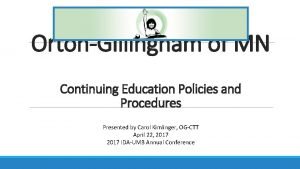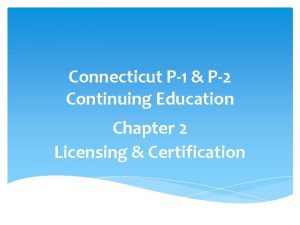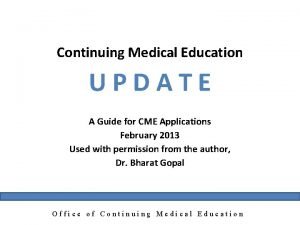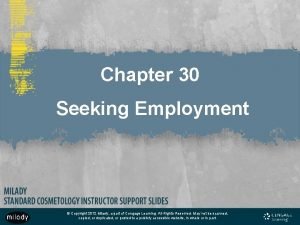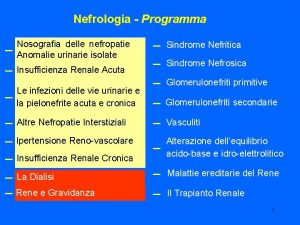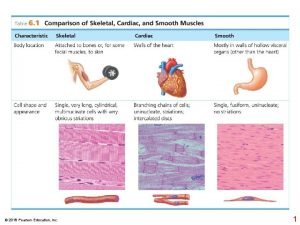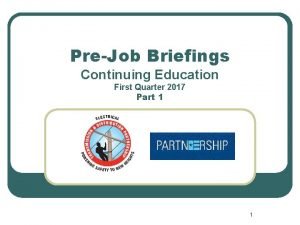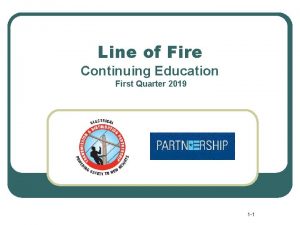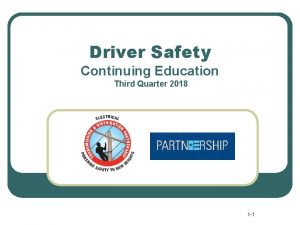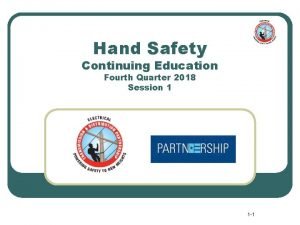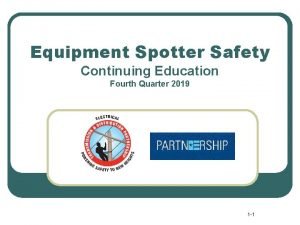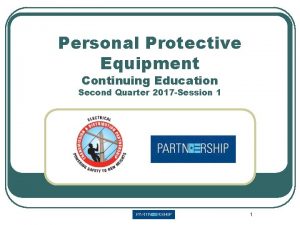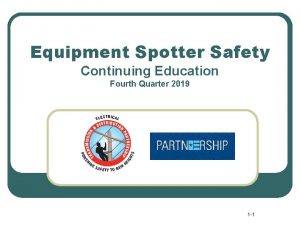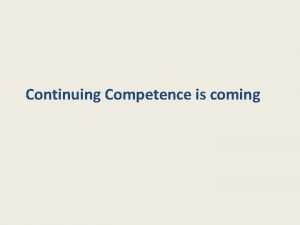Isolate Insulate Continuing Education First Quarter 2018 1

































- Slides: 33

Isolate & Insulate Continuing Education First Quarter 2018 1 -1

Never Second Guess Electrical Hazards! If there is any doubt, STOP! Consult a Supervisor, Journeyman and/or a Safety Professional 1 -2

Objectives Upon completion of this continuing education module you should be able to: þ Describe the difference between Isolate and Insulate þ Describe how current flow through the body can cause injury þ Describe testing requirements for rubber goods and liveline tools þ Describe Minimum Approach Distance (MAD) þ Describe ways to Isolate and/or Insulate workers from electrical hazards 1 -3

Key Safety Fundamental To avoid hazardous differences in electrical potential: Ø Isolate yourself from the hazard Ø Insulate yourself from the hazard 1 -4

Facts Each year workers are killed or seriously injured due to current flow through their body 1 -5

Insulated Defined The IEEE defines Insulated as: • Separated from other conducting surfaces by a dielectric substance or air space permanently offering a high resistance to the passage of current Live-line tools “insulate” the worker from the energized part 1 -6

Insulated Defined OSHA defines Insulated as: • Material relied upon to insulate the conductor from other conductors or conducting parts or from ground Rubber goods “insulate” the worker from the energized part 1 -7

ET&D Best Practice When working on primary conductors utilizing the Gloving Method: • The worker wears insulated rubber gloves and sleeves 1 -8

Insulate Defined The “back-up” systems to a lineman’s insulated rubber gloves are: • An insulated platform • An insulated boom • Insulated covering material 1 -9

Benefit Insulating tools, equipment, and safe work practices allow a worker to safely work on, and around energized equipment and conductors 1 -10

Key Points-Session one 1. 2. 3. Define Insulate. a. To cover with a material relied upon to insulate the conductor from other conductors or conducting parts or from ground. b. To remove the system from normal potentials. c. To remove the person from the exposure. As little as _______ milliamps can cause the heart to stop or go out of its normal rhythm. a. 10 b. 100 c. 1, 000 Never Second Guess Electrical Hazards. a. True b. False 1 -11

Rubber Gloves Rubber gloves and sleeves must be physically and visibly inspected before each use! 2 -1

Insulating Equipment Secure the work area Remove all hazards Protect workers from those hazards that cannot be eliminated 2 -2

Dielectric Test Equipment Type Rubber Glove Inspection Schedule Before first issue then Semi Annually Rubber Sleeve Before first issue then Annually Rubber Blanket Before first issue then Annually Rubber Hose, Hoods etc. Suspect insulating value These are the minimum requirements required by OSHA. Company policy, client and/or contract requirements may mandate shorter inspection cycles 2 -3

Live-Line Tools Minimum approach distance must be maintained • • The worker’s hand The hot end of the stick 2 -4

Live-Line Tools Live-line tools shall be removed from service every 2 years for examination, cleaning, repair, and testing as needed 2 -5

Live Line Tools Each live-line tool shall be wiped clean and visually inspected for defects before use each day Would you do hot work with dirty sticks? Is an insulated boom any different? 2 -6

Live-Line Tools Test the tool's integrity along its entire working length If the tool is made of fiberglass-reinforced plastic, test its integrity under wet conditions 2 -7

Second Point of Contact If any part of a boom can contact an energized phase, cover the phase 2 -8

Second Point of Contact Eliminate second point of contact hazards Cross arm not covered Workers not wearing sleeves Minimum approach distance violation on tie-wire 2 -9

Second Point of Contact Second points of contact include: • • • Pole Cross arm Open spot in cover Guy wires Other phases/Neutral 2 -10

Key Points-Session two 1. List some items to look for when inspecting rubber gloves and sleeves. a. b. c. d. 2. According to OSHA, rubber-insulating gloves are required to be electrically tested at least every _______ months. a. b. c. 3. Holes, Tears, Cuts, Punctures Crazing, Ozone damage, Cracking Deformation, Petroleum damage, Current inspection date All the above 2 4 6 Live-line tools are required to be removed from service and inspected every ______ years. a. b. c. 2 4 6 1 -22

Isolate 3 -1

Generally Speaking You may consider a system, circuit, and/or apparatus isolated when it is physically and mechanically removed from normal sources of potential • The key word here is Normal source • Induction is an Abnormal source Induction 3 -2

Isolate Defined Physically separated, electrically and mechanically, from all sources of electrical energy Such separation may not eliminate the effects of electrical induction! 3 -3

Isolate Defined Not readily accessible to persons unless special means for access are used 3 -4

Primary Voltage Rule Never work on more than one phase at a time If you are not working on a adjacent phase or conductor, it should be covered by approved insulating material 3 -5

Determine Minimum Approach The employer must determine minimum approach distance • Engineering analysis • Customer requirements • OSHA tables 3 -6

Minimum Approach Distance Line workers must maintain the minimum approach distance from exposed energized parts MAD E Energized Part Ergonomic Component 3 -7

Ergonomic Component Employees should be able to perform all of the following actions without straying In other words, the into the minimum approach distance: “Ergonomic Component” of • Adjust his or her hardhat MAD refers to the • Maneuver a tool onto an energized part with a necessary movements a reasonable amount of overreaching or under reaching worker would make to • Reach for and handle tools, material, and perform jobor task equipment passeda to him her • Adjust tools, and replace components on them, when necessary during the work procedure 3 -8

Conductive Objects Minimum Approach Distance starts at the end of a conductive object held in the hand 3 -9

Wrap-up Isolate workers from hazardous potentials or Isolate hazardous potentials from the worker by: • Removing the energized part from normal sources of potential via Open Switches, Remove Jumpers, Open Breakers, Maintain Minimum Approach Distance, Limited Access (i. e. Barricades) To protect workers from hazardous differences in electrical potential a worker can Insulate from the hazard by using: • Cover up, Insulating Gloves & Sleeves, Live Line Tools, Insulated Booms 3 -10

Key Points-Session three 1. Define Isolate. a. Physically separated physically and mechanically, from all sources of electrical energy. b. Grounded and de-energized. c. Covered with line hose. 2. To what does the “Ergonomic Component” of minimum approach distance (MAD) refer? a. A comfortable working position. b. Necessary movements required to perform a job task. c. To use vibration resistant tools. 3. Employers must ensure that employees do not work in a position that if the worker slipped or fell the worker could contact an energized part. a. True b. False 3 -11
 Isolate insulate
Isolate insulate Clock in quarters
Clock in quarters Quarter half past
Quarter half past Thermal bypass checklist
Thermal bypass checklist Heat escaping from house
Heat escaping from house San diego continuing education north city campus
San diego continuing education north city campus Tbpe ethics exam answers
Tbpe ethics exam answers Imslec
Imslec Stanford continuing studies certificate
Stanford continuing studies certificate Meng uconn
Meng uconn P2 plumbing license
P2 plumbing license Institute of continuing & tesol education
Institute of continuing & tesol education Nj institute for continuing legal education
Nj institute for continuing legal education Georgia pe license by comity
Georgia pe license by comity Cara belajar orang dewasa
Cara belajar orang dewasa Dropping out of oxford
Dropping out of oxford Dlgf(dlgf)continuing education/webinars
Dlgf(dlgf)continuing education/webinars Continuing education library oxford
Continuing education library oxford Fclb
Fclb Bladen community college continuing education
Bladen community college continuing education Uic cme
Uic cme American association of continuing medical education
American association of continuing medical education Milady chapter 25 manicuring test answers
Milady chapter 25 manicuring test answers Continuing medical education
Continuing medical education Importance of continuing education
Importance of continuing education Iec irving
Iec irving Aea continuing education
Aea continuing education Isolate storage
Isolate storage Anomalie urinarie isolate
Anomalie urinarie isolate Dada la siguiente secuencia rusia 2018 rusia 2018
Dada la siguiente secuencia rusia 2018 rusia 2018 Which best explains why the moon has phases
Which best explains why the moon has phases First quarter moon gif
First quarter moon gif 2018 pearson education inc
2018 pearson education inc 2018 pearson education inc
2018 pearson education inc







